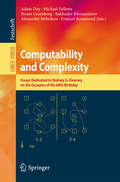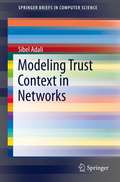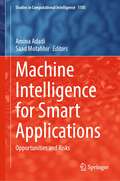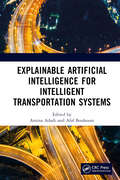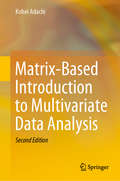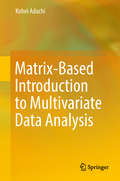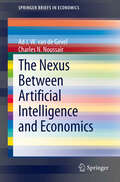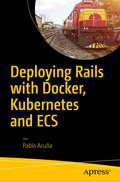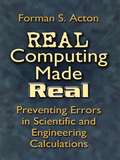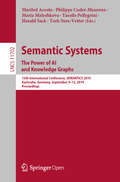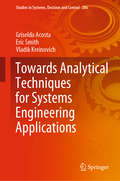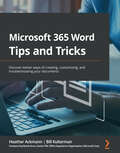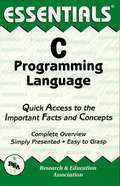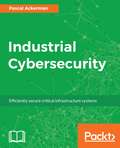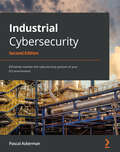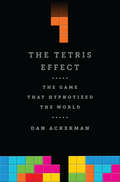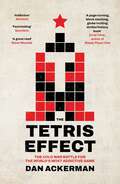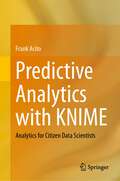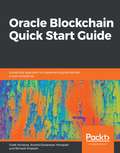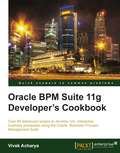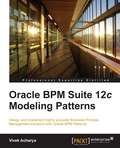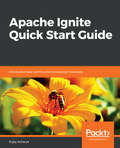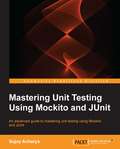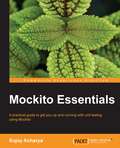- Table View
- List View
Computability and Complexity: Essays Dedicated to Rodney G. Downey on the Occasion of His 60th Birthday (Lecture Notes in Computer Science #10010)
by Adam Day, Michael Fellows, Noam Greenberg, Bakhadyr Khoussainov, Alexander Melnikov and Frances RosamondThis Festschrift is published in honor of Rodney G. Downey, eminent logician and computer scientist, surfer and Scottish country dancer, on the occasion of his 60th birthday.The Festschrift contains papers and laudations that showcase the broad and important scientific, leadership and mentoring contributions made by Rod during his distinguished career. The volume contains 42 papers presenting original unpublished research, or expository and survey results in Turing degrees, computably enumerable sets, computable algebra, computable model theory, algorithmic randomness, reverse mathematics, and parameterized complexity, all areas in which Rod Downey has had significant interests and influence. The volume contains several surveys that make the various areas accessible to non-specialists while also including some proofs that illustrate the flavor of the fields.
Modeling Trust Context in Networks
by Sibel AdaliWe make complex decisions every day, requiring trust in many different entities for different reasons. These decisions are not made by combining many isolated trust evaluations. Many interlocking factors play a role, each dynamically impacting the others. In this brief, "trust context" is defined as the system level description of how the trust evaluation process unfolds. Networks today are part of almost all human activity, supporting and shaping it. Applications increasingly incorporate new interdependencies and new trust contexts. Social networks connect people and organizations throughout the globe in cooperative and competitive activities. Information is created and consumed at a global scale. Systems, devices, and sensors create and process data, manage physical systems, and participate in interactions with other entities, people and systems alike. To study trust in such applications, we need a multi-disciplinary approach. This book reviews the components of the trust context through a broad review of recent literature in many different fields of study. Common threads relevant to the trust context across many application domains are also illustrated.
Machine Intelligence for Smart Applications: Opportunities and Risks (Studies in Computational Intelligence #1105)
by Amina Adadi Saad MotahhirThis book provides insights into recent advances in Machine Intelligence (MI) and related technologies, identifies risks and challenges that are, or could be, slowing down overall MI mainstream adoption and innovation efforts, and discusses potential solutions to address these limitations. All these aspects are explored through the lens of smart applications. The book navigates the landscape of the most recent, prominent, and impactful MI smart applications. The broad set of smart applications for MI is organized into four themes covering all areas of the economy and social life, namely (i) Smart Environment, (ii) Smart Social Living, (iii) Smart Business and Manufacturing, and (iv) Smart Government. The book examines not only present smart applications but also takes a look at how MI may potentially be applied in the future. This book is aimed at researchers and postgraduate students in applied artificial intelligence and allied technologies. The book is also valuable for practitioners, and it serves as a bridge between researchers and practitioners. It also helps connect researchers interested in MI technologies who come from different social and business disciplines and who can benefit from sharing ideas and results.
Explainable Artificial Intelligence for Intelligent Transportation Systems
by Amina Adadi Afaf BouhouteArtificial Intelligence (AI) and Machine Learning (ML) are set to revolutionize all industries, and the Intelligent Transportation Systems (ITS) field is no exception. While ML, especially deep learning models, achieve great performance in terms of accuracy, the outcomes provided are not amenable to human scrutiny and can hardly be explained. This can be very problematic, especially for systems of a safety-critical nature such as transportation systems. Explainable AI (XAI) methods have been proposed to tackle this issue by producing human interpretable representations of machine learning models while maintaining performance. These methods hold the potential to increase public acceptance and trust in AI-based ITS. FEATURES: Provides the necessary background for newcomers to the field (both academics and interested practitioners) Presents a timely snapshot of explainable and interpretable models in ITS applications Discusses ethical, societal, and legal implications of adopting XAI in the context of ITS Identifies future research directions and open problems
Matrix-Based Introduction to Multivariate Data Analysis
by Kohei AdachiThis is the first textbook that allows readers who may be unfamiliar with matrices to understand a variety of multivariate analysis procedures in matrix forms. By explaining which models underlie particular procedures and what objective function is optimized to fit the model to the data, it enables readers to rapidly comprehend multivariate data analysis. Arranged so that readers can intuitively grasp the purposes for which multivariate analysis procedures are used, the book also offers clear explanations of those purposes, with numerical examples preceding the mathematical descriptions.Supporting the modern matrix formulations by highlighting singular value decomposition among theorems in matrix algebra, this book is useful for undergraduate students who have already learned introductory statistics, as well as for graduate students and researchers who are not familiar with matrix-intensive formulations of multivariate data analysis.The book begins by explaining fundamental matrix operations and the matrix expressions of elementary statistics. Then, it offers an introduction to popular multivariate procedures, with each chapter featuring increasing advanced levels of matrix algebra. Further the book includes in six chapters on advanced procedures, covering advanced matrix operations and recently proposed multivariate procedures, such as sparse estimation, together with a clear explication of the differences between principal components and factor analyses solutions. In a nutshell, this book allows readers to gain an understanding of the latest developments in multivariate data science.
Matrix-Based Introduction to Multivariate Data Analysis
by Kohei AdachiThis book enables readers who may not be familiar with matrices to understand a variety of multivariate analysis procedures in matrix forms. Another feature of the book is that it emphasizes what model underlies a procedure and what objective function is optimized for fitting the model to data. The author believes that the matrix-based learning of such models and objective functions is the fastest way to comprehend multivariate data analysis. The text is arranged so that readers can intuitively capture the purposes for which multivariate analysis procedures are utilized: plain explanations of the purposes with numerical examples precede mathematical descriptions in almost every chapter. This volume is appropriate for undergraduate students who already have studied introductory statistics. Graduate students and researchers who are not familiar with matrix-intensive formulations of multivariate data analysis will also find the book useful, as it is based on modern matrix formulations with a special emphasis on singular value decomposition among theorems in matrix algebra. The book begins with an explanation of fundamental matrix operations and the matrix expressions of elementary statistics, followed by the introduction of popular multivariate procedures with advancing levels of matrix algebra chapter by chapter. This organization of the book allows readers without knowledge of matrices to deepen their understanding of multivariate data analysis.
The Nexus between Artificial Intelligence and Economics
by Ad J. van de Gevel Charles N. NoussairThe manuscript reviews some key ideas about artificial intelligence, and relates them to economics. These include its relation to robotics, and the concepts of synthetic emotions, consciousness, and life. The economic implications of the advent of artificial intelligence, such as its effect on prices and wages, appropriate patent policy, and the possibility of accelerating productivity, are discussed. The growing field of artificial economics and the use of artificial agents in experimental economics is considered.
Deploying Rails with Docker, Kubernetes and ECS
by Pablo AcuñaLearn how to use the power of Docker and Kubernetes to deploy your Rails applications easily and efficiently. Deploying Rails with Docker, Kubernetes and ECS shows you how to set up the project, push it to DockerHub, manage services and set up an efficient continuous integration environment. Every concept is clearly explained alongside a full Ruby on Rails application deployment. You’ll also learn how to deploy via Docker using Amazon EC2 Container Service.Docker and Kubernetes are increasing in popularity every day, but what if you want to leverage their benefits for your Rails application? This is the quick guide you need.What You Will LearnCreate a Rails API application using Rails 5 and PostgreSQL, and Dockerize itWrite and test templates to run the application with KubernetesCreate a Kubernetes cluster in Amazon Web Services and run yourInspect and troubleshoot problems in the clusterAutomatize the the whole deployment process with JenkinsWho This Book Is ForThis book is for anyone who wants to understand how to effectively deploy a Rails application using Docker and Kubernetes. You will need to understand Rails and have basic knowledge of what Docker and Kubernetes are used for.
Real Computing Made Real: Preventing Errors in Scientific and Engineering Calculations
by Forman S. ActonEngineers and scientists who want to avoid insidious errors in their computer-assisted calculations will welcome this concise guide to trouble-shooting. Real Computing Made Real offers practical advice on detecting and removing bugs. It also outlines techniques for preserving significant figures, avoiding extraneous solutions, and finding efficient iterative processes for solving nonlinear equations.Those who compute with real numbers (for example, floating-point numbers stored with limited precision) tend to develop techniques that increase the frequency of useful answers. But although there might be ample guidance for those addressing linear problems, little help awaits those negotiating the nonlinear world. This book, geared toward upper-level undergraduates and graduate students, helps rectify that imbalance. Its examples and exercises (with answers) help readers develop problem-formulating skills and assist them in avoiding the common pitfalls that software packages seldom detect. Some experience with standard numerical methods is assumed, but beginners will find this volume a highly practical introduction, particularly in its treatment of often-overlooked topics.
Semantic Systems. The Power of AI and Knowledge Graphs: 15th International Conference, SEMANTiCS 2019, Karlsruhe, Germany, September 9–12, 2019, Proceedings (Lecture Notes in Computer Science #11702)
by Maribel Acosta Philippe Cudré-Mauroux Maria Maleshkova Tassilo Pellegrini Harald Sack York Sure-VetterThis open access book constitutes the refereed proceedings of the 15th International Conference on Semantic Systems, SEMANTiCS 2019, held in Karlsruhe, Germany, in September 2019. The 20 full papers and 8 short papers presented in this volume were carefully reviewed and selected from 88 submissions. They cover topics such as: web semantics and linked (open) data; machine learning and deep learning techniques; semantic information management and knowledge integration; terminology, thesaurus and ontology management; data mining and knowledge discovery; semantics in blockchain and distributed ledger technologies.
Towards Analytical Techniques for Systems Engineering Applications (Studies in Systems, Decision and Control #286)
by Griselda Acosta Eric Smith Vladik KreinovichThis book is intended for specialists in systems engineering interested in new, general techniques and for students and practitioners interested in using these techniques for solving specific practical problems. For many real-world, complex systems, it is possible to create easy-to-compute explicit analytical models instead of time-consuming computer simulations. Usually, however, analytical models are designed on a case-by-case basis, and there is a scarcity of general techniques for designing such easy-to-compute models. This book fills this gap by providing general recommendations for using analytical techniques in all stages of system design, implementation, testing, and monitoring. It also illustrates these recommendations using applications in various domains, such as more traditional engineering systems, biological systems (e.g., systems for cattle management), and medical and social-related systems (e.g., recommender systems).
Microsoft 365 Word Tips and Tricks: Discover top features and expert techniques for creating, editing, customizing, and troubleshooting documents
by Heather Ackmann Bill Kulterman Ramit AroraExplore Word's top tools and undiscovered features, and learn how to use them optimally in a business or real-world settingKey FeaturesUse MS Word more efficiently and leverage this handy guide to help you when you get stuckCollaborate online effectively and format a variety of professional documents expertlyHone your MS Word troubleshooting skills to solve formatting problems and issues encountered by everyday usersBook DescriptionMicrosoft Word, or MS Word, is a word processor developed by Microsoft. Although Word is one of the office productivity applications included in the Microsoft Office suite, it can also be purchased as a standalone product. MS Word enables you to create, edit, and save professional documents, among other helpful features. Anyone who wants to get better at working with Word will be able to put their MS Word knowledge to use with this practical guide.The book takes a hands-on problem- and solution-based approach to implementation and provides associated methodologies that will have you up and running and productive in no time. Complete with step-by-step explanations of essential concepts and practical examples, you'll begin by exploring different versions of Microsoft Word and understand how these versions impact collaboration with others, along with exploring the features available. Throughout the book, you'll learn how to work more productively and efficiently, with others as well as by yourself, using Word's sharing and collaboration features and the new reading and accessibility features.By the end of this Microsoft Word book, you will be able to troubleshoot common issues that may arise when working with documents.What you will learnTrack a document's changes as well as comment on and review changes by others, both locally and remotelyUse Word's navigation and view features to improve productivityGenerate more consistently formatted documents with StylesPerform common tasks through simple formatting techniques, Quick Parts, customizing AutoCorrect/AutoFormat, and memorizing keyboard shortcutsTroubleshoot the most frustrating formatting problems experienced by Word usersCreate more universally accessible documents by adding Alt Text using the accessibility checker and other Word featuresWho this book is forThis book is for business professionals with basic experience of Office apps looking to utilize the Windows version of Microsoft Word to create, edit, format, read, print, and collaborate with short and long documents at home, at work, and on the go. The book assumes some very basic knowledge of Word and word processing programs in general, such as open, save, copy, and paste.
C Programming Language Essentials
by Ernest C. AckermannREA's Essentials provide quick and easy access to critical information in a variety of different fields, ranging from the most basic to the most advanced. As its name implies, these concise, comprehensive study guides summarize the essentials of the field covered. Essentials are helpful when preparing for exams, doing homework and will remain a lasting reference source for students, teachers, and professionals. C Programming Language discusses fundamental notions, data types and objects, expressions, statements, declarations, function and program structure, the preprocessor, and the standard library.
Industrial Cybersecurity
by Pascal AckermanYour one-step guide to understanding industrial cyber security, its control systems, and its operations. About This Book • Learn about endpoint protection such as anti-malware implementation, updating, monitoring, and sanitizing user workloads and mobile devices • Filled with practical examples to help you secure critical infrastructure systems efficiently • A step-by-step guide that will teach you the techniques and methodologies of building robust infrastructure systems Who This Book Is For If you are a security professional and want to ensure a robust environment for critical infrastructure systems, this book is for you. IT professionals interested in getting into the cyber security domain or who are looking at gaining industrial cyber security certifications will also find this book useful. What You Will Learn • Understand industrial cybersecurity, its control systems and operations • Design security-oriented architectures, network segmentation, and security support services • Configure event monitoring systems, anti-malware applications, and endpoint security • Gain knowledge of ICS risks, threat detection, and access management • Learn about patch management and life cycle management • Secure your industrial control systems from design through retirement In Detail With industries expanding, cyber attacks have increased significantly. Understanding your control system's vulnerabilities and learning techniques to defend critical infrastructure systems from cyber threats is increasingly important. With the help of real-world use cases, this book will teach you the methodologies and security measures necessary to protect critical infrastructure systems and will get you up to speed with identifying unique challenges.Industrial cybersecurity begins by introducing Industrial Control System (ICS) technology, including ICS architectures, communication media, and protocols. This is followed by a presentation on ICS (in) security. After presenting an ICS-related attack scenario, securing of the ICS is discussed, including topics such as network segmentation, defense-in-depth strategies, and protective solutions. Along with practical examples for protecting industrial control systems, this book details security assessments, risk management, and security program development. It also covers essential cybersecurity aspects, such as threat detection and access management. Topics related to endpoint hardening such as monitoring, updating, and anti-malware implementations are also discussed. Style and approach A step-by-step guide to implement Industrial Cyber Security effectively.
Industrial Cybersecurity: Efficiently monitor the cybersecurity posture of your ICS environment, 2nd Edition
by Pascal AckermanGet up and running with industrial cybersecurity monitoring with this hands-on book, and explore ICS cybersecurity monitoring tasks, activities, tools, and best practicesKey FeaturesArchitect, design, and build ICS networks with security in mindPerform a variety of security assessments, checks, and verificationsEnsure that your security processes are effective, complete, and relevantBook DescriptionWith Industrial Control Systems (ICS) expanding into traditional IT space and even into the cloud, the attack surface of ICS environments has increased significantly, making it crucial to recognize your ICS vulnerabilities and implement advanced techniques for monitoring and defending against rapidly evolving cyber threats to critical infrastructure. This second edition covers the updated Industrial Demilitarized Zone (IDMZ) architecture and shows you how to implement, verify, and monitor a holistic security program for your ICS environment. You'll begin by learning how to design security-oriented architecture that allows you to implement the tools, techniques, and activities covered in this book effectively and easily. You'll get to grips with the monitoring, tracking, and trending (visualizing) and procedures of ICS cybersecurity risks as well as understand the overall security program and posture/hygiene of the ICS environment. The book then introduces you to threat hunting principles, tools, and techniques to help you identify malicious activity successfully. Finally, you'll work with incident response and incident recovery tools and techniques in an ICS environment. By the end of this book, you'll have gained a solid understanding of industrial cybersecurity monitoring, assessments, incident response activities, as well as threat hunting.What you will learnMonitor the ICS security posture actively as well as passivelyRespond to incidents in a controlled and standard wayUnderstand what incident response activities are required in your ICS environmentPerform threat-hunting exercises using the Elasticsearch, Logstash, and Kibana (ELK) stackAssess the overall effectiveness of your ICS cybersecurity programDiscover tools, techniques, methodologies, and activities to perform risk assessments for your ICS environmentWho this book is forIf you are an ICS security professional or anyone curious about ICS cybersecurity for extending, improving, monitoring, and validating your ICS cybersecurity posture, then this book is for you. IT/OT professionals interested in entering the ICS cybersecurity monitoring domain or searching for additional learning material for different industry-leading cybersecurity certifications will also find this book useful.
Jihadists and Weapons of Mass Destruction
by Gary Ackerman Jeremy TamsettExplores the Nexus Formed When Malevolent Actors Access Malignant MeansWritten for professionals, academics, and policymakers working at the forefront of counterterrorism efforts, Jihadists and Weapons of Mass Destruction is an authoritative and comprehensive work addressing the threat of weapons of mass destruction (WMD) in the hands of jihadists,
The Tetris Effect: The Game that Hypnotized the World
by Dan AckermanThe definitive story of a game so great, even the Cold War couldn't stop itTetris is perhaps the most instantly recognizable, popular video game ever made. But how did an obscure Soviet programmer, working on frail, antiquated computers, create a product which has now earned nearly 1 billion in sales? How did a makeshift game turn into a worldwide sensation, which has been displayed at the Museum of Modern Art, inspired a big-budget sci-fi movie, and been played in outer space?A quiet but brilliant young man, Alexey Pajitnov had long nurtured a love for the obscure puzzle game pentominoes, and became obsessed with turning it into a computer game. Little did he know that the project that he labored on alone, hour after hour, would soon become the most addictive game ever made.In this fast-paced business story, reporter Dan Ackerman reveals how Tetris became one of the world's first viral hits, passed from player to player, eventually breaking through the Iron Curtain into the West. British, American, and Japanese moguls waged a bitter fight over the rights, sending their fixers racing around the globe to secure backroom deals, while a secretive Soviet organization named ELORG chased down the game's growing global profits.The Tetris Effect is an homage to both creator and creation, and a must-read for anyone who's ever played the game—which is to say everyone.
The Tetris Effect: The Cold War Battle for the World's Most Addictive Game
by Dan Ackerman21 February 1989. Three men fly into Moscow, representing software giants from Britain, America, and Japan. Each of them is determined to undercut the others in order to secure a technology so powerfully addictive it has brought the government department that created it to a standstill. In a country on the brink of seismic change, where spycraft is about to give way to cut-throat capitalism, Tetris has become the grand prize. Featuring corporate espionage, unmarked government organizations, courtroom drama and international conspiracies, the origin of the world&’s most popular video game is a gripping, fast-paced thriller of the highest order. Not only this, but it is also the tale of a one-in-a-million software start-up – a unique example of an idea, a product, and an era coming together at exactly the right moment. Tetris was perfectly (if accidentally) crafted to hit primal triggers in our minds and in Ackerman&’s hands its story is unputdownable.
Predictive Analytics with KNIME: Analytics for Citizen Data Scientists
by Frank AcitoThis book is about data analytics, including problem definition, data preparation, and data analysis. A variety of techniques (e.g., regression, logistic regression, cluster analysis, neural nets, decision trees, and others) are covered with conceptual background as well as demonstrations of KNIME using each tool. The book uses KNIME, which is a comprehensive, open-source software tool for analytics that does not require coding but instead uses an intuitive drag-and-drop workflow to create a network of connected nodes on an interactive canvas. KNIME workflows provide graphic representations of each step taken in analyses, making the analyses self-documenting. The graphical documentation makes it easy to reproduce analyses, as well as to communicate methods and results to others. Integration with R is also available in KNIME, and several examples using R nodes in a KNIME workflow are demonstrated for special functions and tools not explicitly included in KNIME.
Oracle Blockchain Quick Start Guide: A practical approach to implementing blockchain in your enterprise
by Vivek Acharya Anand Eswararao Yerrapati Nimesh PrakashGet up and running with Oracle's premium cloud blockchain services and build distributed blockchain apps with ease Key Features Discover Hyperledger Fabric and its components, features, qualifiers, and architecture Get familiar with the Oracle Blockchain Platform and its unique features Build Hyperledger Fabric-based business networks with Oracle's premium blockchain cloud service Book Description Hyperledger Fabric empowers enterprises to scale out in an unprecedented way, allowing organizations to build and manage blockchain business networks. This quick start guide systematically takes you through distributed ledger technology, blockchain, and Hyperledger Fabric while also helping you understand the significance of Blockchain-as-a-Service (BaaS). The book starts by explaining the blockchain and Hyperledger Fabric architectures. You'll then get to grips with the comprehensive five-step design strategy - explore, engage, experiment, experience, and in?uence. Next, you'll cover permissioned distributed autonomous organizations (pDAOs), along with the equation to quantify a blockchain solution for a given use case. As you progress, you'll learn how to model your blockchain business network by defining its assets, participants, transactions, and permissions with the help of examples. In the concluding chapters, you'll build on your knowledge as you explore Oracle Blockchain Platform (OBP) in depth and learn how to translate network topology on OBP. By the end of this book, you will be well-versed with OBP and have developed the skills required for infrastructure setup, access control, adding chaincode to a business network, and exposing chaincode to a DApp using REST configuration. What you will learn Model your blockchain-based business network by defining its components, transactions, integrations, and infrastructure through use cases Develop, deploy, and test chaincode using shim and REST, and integrate it with client apps using SDK, REST, and events Explore accounting, blockchain, hyperledger fabric, and its components, features, qualifiers, architecture and structure Understand the importance of Blockchain-as-a-Service (BaaS) Experiment Hyperledger Fabric and delve into the underlying technology Set up a consortium network, nodes, channels, and privacy, and learn how to translate network topology on OBP Who this book is for If you are a blockchain developer, blockchain architect or just a cloud developer looking to get hands-on with Oracle Blockchain Cloud Service, then this book is for you. Some familiarity with the basic concepts of blockchain will be helpful to get the most out of this book
Oracle BPM Suite 11g Developer's cookbook
by Vivek AcharyaThis book is written in simple, easy to understand format with lots of screenshots and step-by-step explanations. If you are a BPM,Oracle SOA or Oracle Fusion Applications - developer, designer, artitect, end-user looking to develop BPM solutions without impediments, then this is the best guide for you. Book assume that you have fundamental knowledge of BPM.
Oracle BPM Suite 12c Modeling Patterns
by Vivek AcharyaThis book is an invaluable resource if you are an Enterprise architect, solution architect, developer, process analyst, or application functional and technical consultant who uses Business Process Management and BPMN to model and implement Enterprise IT applications, SaaS, and cloud applications.
Apache Ignite Quick Start Guide: Distributed data caching and processing made easy
by Sujoy AcharyaBuild efficient, high-performance & scalable systems to process large volumes of data with Apache IgniteKey FeaturesUnderstand Apache Ignite's in-memory technologyCreate High-Performance app components with IgniteBuild a real-time data streaming and complex event processing systemBook DescriptionApache Ignite is a distributed in-memory platform designed to scale and process large volume of data. It can be integrated with microservices as well as monolithic systems, and can be used as a scalable, highly available and performant deployment platform for microservices. This book will teach you to use Apache Ignite for building a high-performance, scalable, highly available system architecture with data integrity.The book takes you through the basics of Apache Ignite and in-memory technologies. You will learn about installation and clustering Ignite nodes, caching topologies, and various caching strategies, such as cache aside, read and write through, and write behind. Next, you will delve into detailed aspects of Ignite’s data grid: web session clustering and querying data.You will learn how to process large volumes of data using compute grid and Ignite’s map-reduce and executor service. You will learn about the memory architecture of Apache Ignite and monitoring memory and caches. You will use Ignite for complex event processing, event streaming, and the time-series predictions of opportunities and threats. Additionally, you will go through off-heap and on-heap caching, swapping, and native and Spring framework integration with Apache Ignite.By the end of this book, you will be confident with all the features of Apache Ignite 2.x that can be used to build a high-performance system architecture.What you will learnUse Apache Ignite’s data grid and implement web session clusteringGain high performance and linear scalability with in-memory distributed data processingCreate a microservice on top of Apache Ignite that can scale and performPerform ACID-compliant CRUD operations on an Ignite cacheRetrieve data from Apache Ignite’s data grid using SQL, Scan and Lucene Text queryExplore complex event processing concepts and event streamingIntegrate your Ignite app with the Spring frameworkWho this book is forThe book is for Big Data professionals who want to learn the essentials of Apache Ignite. Prior experience in Java is necessary.
Mastering Unit Testing Using Mockito and JUnit
by Sujoy AcharyaA practical and easy-to-follow, yet comprehensive, guide to learning advanced JUnit testing. Each topic is explained and placed in context, and for the more inquisitive, there are more details of the concepts used. This book is for you if you are a developer with some experience in Java application development as well as a basic knowledge of JUnit testing. But for those whose skill set is void of any prior experience with JUnit testing, the book also covers basic fundamentals to get you acquainted with the concepts before putting them into practise.
Mockito Essentials
by Sujoy AcharyaThis book is ideal for developers who have some experience in Java application development as well as some basic knowledge of test doubles and JUnit testing. This book also introduces you to the fundamentals of JUnit testing, test doubles, refactoring legacy code, and writing JUnit tests for GWT and web services.
